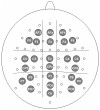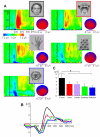Human face preference in gamma-frequency EEG activity
- PMID: 18083564
- PMCID: PMC2268116
- DOI: 10.1016/j.neuroimage.2007.10.025
Human face preference in gamma-frequency EEG activity
Abstract
Previous studies demonstrated that induced EEG activity in the gamma band (iGBA) plays an important role in object recognition and is modulated by stimulus familiarity and its compatibility with pre-existent representations. In the present study we investigated the modulation of iGBA by the degree of familiarity and perceptual expertise that observers have with stimuli from different categories. Specifically, we compared iGBA in response to human faces versus stimuli which subjects are not expert with (ape faces, human hands, buildings and watches). iGBA elicited by human faces was higher and peaked earlier than that elicited by all other categories, which did not differ significantly from each other. These findings can be accounted for by two characteristics of perceptual expertise. One is the activation of a richer, stronger and, therefore, more easily accessible mental representation of human faces. The second is the more detailed perceptual processing necessary for within-category distinctions, which is the hallmark of perceptual expertise. In addition, the sensitivity of iGBA to human but not ape faces was contrasted with the face-sensitive N170-effect, which was similar for human and ape faces. In concert with previous studies, this dissociation suggests a multi-level neuronal model of face recognition, manifested by these two electrophysiological measures, discussed in this paper.
Figures




Similar articles
-
The commonality between the perceptual adaptation mechanisms involved in processing faces and nonface objects of expertise.Neuropsychology. 2015 Sep;29(5):715-25. doi: 10.1037/neu0000170. Epub 2015 Feb 2. Neuropsychology. 2015. PMID: 25643216
-
Face, eye and object early processing: what is the face specificity?Neuroimage. 2006 Jan 15;29(2):667-76. doi: 10.1016/j.neuroimage.2005.07.041. Epub 2005 Sep 19. Neuroimage. 2006. PMID: 16169749
-
Electrophysiological neural mechanisms for detection, configural analysis and recognition of faces.Neuroimage. 2007 Oct 1;37(4):1407-16. doi: 10.1016/j.neuroimage.2007.05.054. Epub 2007 Jun 14. Neuroimage. 2007. PMID: 17689102
-
Familiarity effects on categorization levels of faces and objects.Cognition. 2009 Apr;111(1):144-9. doi: 10.1016/j.cognition.2009.01.002. Epub 2009 Feb 12. Cognition. 2009. PMID: 19217085 Free PMC article.
-
The N170 is Sensitive to Long-term (Personal) Familiarity of a Face Identity.Neuroscience. 2021 Mar 15;458:244-255. doi: 10.1016/j.neuroscience.2020.12.036. Epub 2021 Jan 16. Neuroscience. 2021. PMID: 33460730 Review.
Cited by
-
Disconnection from others in autism is more than just a feeling: whole-brain neural synchrony in adults during implicit processing of emotional faces.Mol Autism. 2017 Feb 22;8:7. doi: 10.1186/s13229-017-0123-2. eCollection 2017. Mol Autism. 2017. PMID: 28316771 Free PMC article.
-
Neural dynamics associated with semantic and episodic memory for faces: evidence from multiple frequency bands.J Cogn Neurosci. 2010 Feb;22(2):263-77. doi: 10.1162/jocn.2009.21251. J Cogn Neurosci. 2010. PMID: 19400676 Free PMC article.
-
Using multi-modal neuroimaging to characterise social brain specialisation in infants.Elife. 2023 Oct 11;12:e84122. doi: 10.7554/eLife.84122. Elife. 2023. PMID: 37818944 Free PMC article.
-
Regional Beta Index of Electroencephalography May Differentiate Alzheimer's Disease from Depression.Psychiatry Investig. 2017 Sep;14(5):708-711. doi: 10.4306/pi.2017.14.5.708. Epub 2017 Sep 11. Psychiatry Investig. 2017. PMID: 29042900 Free PMC article.
-
Disordered high-frequency oscillation in face processing in schizophrenia patients.Medicine (Baltimore). 2018 Feb;97(6):e9753. doi: 10.1097/MD.0000000000009753. Medicine (Baltimore). 2018. PMID: 29419668 Free PMC article.
References
-
- Anaki D, Zion-Golumbic E, Bentin S. Electrophysiological neural mechanisms for detection, configural analysis and recognition of faces. NeuroImage. in press. - PubMed
-
- Bauer R, Brosch M, Eckhorn R. Different rules of spatial summation from beyond the receptive field for spike rates and oscillation amplitudes in cat visual cortex. Brain Res. 1995;669(2):291–7. - PubMed
-
- Bertrand O, Tallon-Baudry C. Oscillatory gamma activity in humans: a possible role for object representation. Int. J. Psychophysiol. 2000;38:211–223. - PubMed
-
- Boutet I, Gentes-Hawn A, Chaudhuri A. The influence of attention on holistic face encoding. Cognition. 2002;84:321–341. - PubMed
-
- Bruce V, Young A. Understanding face recognition. Br J Psychol. 1986;77:305–27. - PubMed
Publication types
MeSH terms
Grants and funding
LinkOut - more resources
Full Text Sources
Molecular Biology Databases
Research Materials
Miscellaneous

